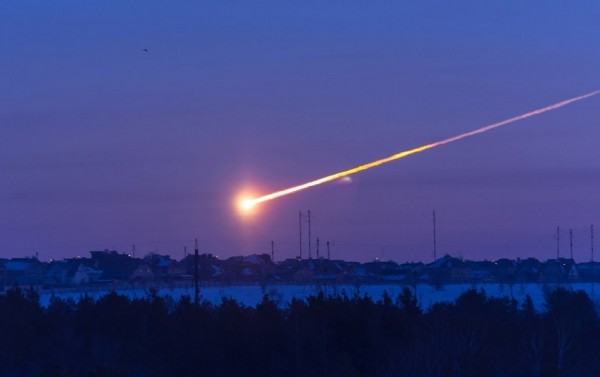By Ana Verayo, | February 24, 2016

Chelyabinsk meteor that hit Russia in February 2013.
A potential asteroid impact could spell catastrophic disaster for Earth however, asteroids and meteors are apparently entering the planet's atmosphere without anyone noticing it as a gigantic fireball crashed into the south Atlantic Ocean last February 6, ending in a fiery explosion some 30 kilometers above the sea.
Like Us on Facebook
Scientists believe that this fireball is the biggest one yet to hit Earth since the Chelyabinsk incident in Russia last February 2013. This impact occurred around 9:00 A.M. EST off the Brazilian coast as the fireball was estimated to possess a power of 13,000 tons of TNT which is a small fraction of the Chelyabinsk explosion that blasted off 500,000 tons of TNT as it passed by the Ural mountains, even releasing a sonic boom, heard across the city.
Scientists estimate that this space rock measured some five to several meters in diameter based on its high altitude impact. In comparison, the Chelyabinsk meteor was 20 meters across which could be regarded as similar events, but since the Russian impact produced a powerful sonic boom, did this asteroid produced a sound as well?
According to famous astronomer Phil Plait, as he investigated and calculated why this incident mysteriously went unnoticed, he revealed that this major event went unseen since it is distant enough for any human to hear or see it, about 1,000 kilometers of the southeastern coast of Rio de Janeiro.
Large asteroids or meteors or any sizable space rock that enters the planet's atmosphere can cause an Earth shattering impact leaving a blazing trail in the skies. If the rock is big enough, the rock will not disintegrate as it enters the atmosphere which will the burn shortly after. The rock then forms a compression of gas in front of it which can generate intense heat, making it glow. The space rock could either evaporate completely or blow apart, that can slow down its trajectory or disappear into pieces or dust.
Bigger asteroids or meteors can explode and break apart due to powerful air pressures that can burn up smaller debris that are falling off across the atmosphere. When the Chelyabinsk entered the atmosphere, it was breaking up producing bright sparks that were both occurring so fast as its massive energy was expelled all at the same time.
Plait says that the asteroid that entered Earth last February 6 was so far from any human community that it was unlikely that anybody had a glimpse of it or obtained any direct observations. Chelyabinsk, on the other hand, was populated with more than 1 million residents, that also resulted in more than 1,000 injuries.
NASA detected this gigantic fireball through the U.S. military, however data received by NASA's Jet Propulsion Laboratory's Near Earth Object Program was only limited to the meteor's time and direction it was headed.
-
Use of Coronavirus Pandemic Drones Raises Privacy Concerns: Drones Spread Fear, Local Officials Say

-
Coronavirus Hampers The Delivery Of Lockheed Martin F-35 Stealth Fighters For 2020

-
Instagram Speeds Up Plans to Add Account Memorialization Feature Due to COVID-19 Deaths

-
NASA: Perseverance Plans to Bring 'Mars Rock' to Earth in 2031

-
600 Dead And 3,000 In The Hospital as Iranians Believed Drinking High-Concentrations of Alcohol Can Cure The Coronavirus

-
600 Dead And 3,000 In The Hospital as Iranians Believed Drinking High-Concentrations of Alcohol Can Cure The Coronavirus

-
COVID-19: Doctors, Nurses Use Virtual Reality to Learn New Skills in Treating Coronavirus Patients







